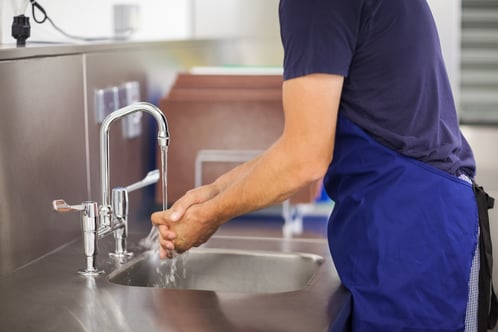When visiting a new restaurant or a food retail store, an employee’s personal hygiene greatly influences the perception of the store's overall cleanliness. Businesses in the food industry should always strive to avoid any issues related to personal hygiene. Programs and training must be in place to improve personal hygiene, which includes knowledge of foodborne illnesses, employee responsibility, management responsibility, and third-party services.

The Big 5
Let’s begin with the “Big 5” foodborne pathogens stated by the CDC and the FDA. These five foodborne pathogens include norovirus, the Hepatitis A virus, Salmonella, Shigella, and Escherichia coli (E. coli) O157:H7. Other less infectious pathogens that can be transmitted by food employees to consumers through contaminated food include Staphylococcus aureus (staph infection) and Streptococcus progenies.
- Norovirus is a highly contagious virus that can cause symptoms such as diarrhea, throwing up, and stomach pain. About 20 million people contract norovirus each year, most from close contact with infected people or by eating contaminated food. Norovirus is the leading cause of disease outbreaks from contaminated food in the U.S. Infected food workers cause about 70 percent of reported norovirus outbreaks. Contrary to popular belief, hand sanitizers are largely ineffective against norovirus, which is why proper handwashing with soap and water is necessary.
- Hepatitis A is a contagious liver disease that results from infection with the Hepatitis A virus. It ranges in severity from a mild illness lasting a few weeks to a severe illness lasting several months. Hepatitis A is usually spread when a person ingests the virus from contact with objects, foods, or drinks contaminated by feces or stool from an infected person. It is a must that all employees thoroughly wash their hands and fingernails after using the restroom. Some counties in the U.S. require all food handlers to be vaccinated against Hepatitis A.
- Salmonellosis, the illness caused by Salmonella, primarily results in a mild to severe diarrheal illness, known as acute gastroenteritis. The CDC estimates that approximately 1.2 million illnesses and 450 deaths occur due to non-typhoidal Salmonella annually in the U.S. Person to person transmission of Salmonella occurs when an infected person’s feces, unwashed from his or her hands, contaminates food during preparation or comes into direct contact with another person.
- Shigellosis is a diarrheal disease caused by a group of bacteria called Shigella. Most who are infected with Shigella develop diarrhea, fever, and stomach cramps starting a day or two after they are exposed to the bacteria. Shigellosis usually resolves in 5 to 7 days. Shigella causes about 500,000 cases of diarrhea in the U.S. annually. Shigella is found in the intestinal tract of infected people, and is spread by eating or drinking food or water contaminated with the bacteria.
- E. coli is a large and diverse group of bacteria. Although most strains of E. coli are harmless, others can make you sick. Some types of E. coli can cause diarrhea, while others cause urinary tract infections, respiratory illness and pneumonia, and other illnesses. Still, other types of E. coli are used as markers for water contamination, so you might hear about E. coli being found in drinking water, which are not themselves harmful, but indicate the water is contaminated. E. coli O157:H7 is transmitted to humans primarily through consumption of contaminated foods, such as raw or undercooked ground meat products and raw milk.
Preventive Measures
So what can restaurants and retailers do to mitigate the risk? It all begins with the policies and management in place. The manager must ensure that food employees are trained in the causes and prevention of foodborne illnesses. Employers will benefit greatly if their employees understand the relationship between their job, personal hygiene, and foodborne illnesses. Management should explain to all food service employees the importance of reporting specific symptoms and any diagnoses or exposures to foodborne illness. If an employee is experiencing any vomiting or diarrhea, the manager should ask the food employee to stop work immediately and leave the food establishment. The employee should return to work no sooner than 24 hours after vomiting and diarrhea have ended.
 Food employees share the responsibility with management for preventing foodborne illnesses and are required to know the causes and prevention of these illnesses. They need to immediately report symptoms of vomiting, diarrhea, jaundice, sore throat with fever, diagnosis or exposure of illness caused by a “Big 5” pathogen, or an exposed infected wound or cut on the hands or arms to their manager. Food employees can work with a non-infectious condition as long as they can provide medical documentation indicating that the symptoms are from a non-infectious condition. Some non-infectious conditions include Crohn’s disease (an ongoing disorder that causes inflammation of the gastrointestinal system), irritable bowel syndrome, some liver diseases, and symptoms commonly experienced during stages of pregnancy. Employees can help prevent foodborne illness by avoiding work when ill, not touching ready-to-eat food with bare hands, and washing hands frequently, especially whenever they are soiled or have touched anything that has contaminated them.
Food employees share the responsibility with management for preventing foodborne illnesses and are required to know the causes and prevention of these illnesses. They need to immediately report symptoms of vomiting, diarrhea, jaundice, sore throat with fever, diagnosis or exposure of illness caused by a “Big 5” pathogen, or an exposed infected wound or cut on the hands or arms to their manager. Food employees can work with a non-infectious condition as long as they can provide medical documentation indicating that the symptoms are from a non-infectious condition. Some non-infectious conditions include Crohn’s disease (an ongoing disorder that causes inflammation of the gastrointestinal system), irritable bowel syndrome, some liver diseases, and symptoms commonly experienced during stages of pregnancy. Employees can help prevent foodborne illness by avoiding work when ill, not touching ready-to-eat food with bare hands, and washing hands frequently, especially whenever they are soiled or have touched anything that has contaminated them.
Along with foodborne illnesses, allergens can be spread without proper personal hygiene and handwashing. For example, if an employee has peanut residue on his hands while serving a customer with a peanut allergy, it can have detrimental effects. All employees must wash their hands properly before entering the workplace from a break.
Helpful Services
Once the management and employees know what to do in these situations, it is a good idea to see what services are out there to improve food safety programs. The first step should be to look into available training and certifications. An example of a beneficial program for retail and restaurants is the ServSafe Food Handler Program, which is broken into sections. The five sections are Basic Food Safety, Personal Hygiene, Cross-Contamination and Allergens, Time and Temperature, and Cleaning and Sanitation. You must complete these sections before the assessment is available. There is an optional Job Specific section that your manager may want you to complete.
After the programs and training are in place, it can be beneficial for a third-party company to come out for an inspection. Food safety auditing companies, like ASI Food Safety, offer specific third-party audits that check your current programs and practices.
During an independent audit, ASI will look at the facility’s:
- food safety practices
- employee practices
- programs
- training
- maintenance
- pest control.
ASI will also ensure associates wash their hands, fingernails, and arms with liquid hand soap, followed by an alcohol-based hand sanitizer after a break or lunch. This will mitigate the risk of spreading foodborne illnesses and allergens.
Programs and training must be in place to improve personal hygiene, which includes knowledge of foodborne illnesses, employee responsibility, management responsibility, and third-party services that are offered. Improper personal hygiene can carry weight on your establishment if an outbreak is linked to your product.
Employees should be educated on the importance of personal hygiene to mitigate the risk of foodborne illnesses and allergens. Remember, one negative online review or a pathogen outbreak linked to your establishment can go a long way in today’s world.

COMMENTS